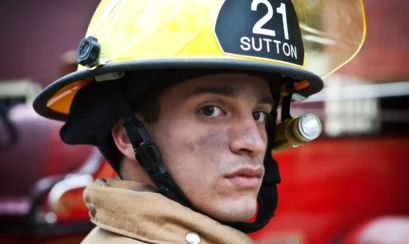Jumping castle an attraction at school event
Although more than three years have passed since the Tasmanian jumping castle accident, the tragedy is still fresh in our minds.
On 16 December 2021 there was an event, the “Big Day In” at Hillcrest Public School in Devonport, on the north coast of Tasmania. The weather was fine and clear, with little, if any, wind.
One of the attractions was a jumping castle, provided by Taz-Zorb, which was the trading name of a business run by Ms Rosemary Gamble. She had purchased the US-made inflatable device from an Australian importer.
However, despite the castle having eight anchorage points with rings allowing it to be secured to the ground, it was supplied with only four pegs, and without an instruction manual. And, as it turned out, the ground was unusually hard, such that the pegs could be driven in only vertically, rather than at an angle.
“Dust devil” lifts jumping castle and carries it 70 metres
At about 10 am a number of primary-age children were playing in the castle, some of them in “zorb balls”. (Zorb balls are inflatable spheres big enough to accommodate a person, allowing the person to roll around in what was referred to in the hearing as an inflatable zorb ball “arena”.)
Then, without warning, a “dust devil” appeared. A dust devil is, on one level, a wind; although on another level “wind” is not a very accurate descriptor. Of this, more later.
Accounts of the duration of the phenomenon varied from a few seconds to just under a minute. In that time the castle had been lifted off the ground and carried about 70 metres from where it had been placed. Estimates given by eyewitnesses were that the castle was as far off the ground as ten metres.
The castle was rotating and crumpling in the process. Children were spilled from the airborne device, including one who was evidently struck in the head by the blower used to inflate the castle. Six died, either at the scene or later in hospital. Others were seriously injured.
Business owner prosecuted for breaching work health and safety laws
Ms Gamble was prosecuted over an alleged breach of workplace health and safety laws. On 6 June 2025 the charge was dismissed by a magistrate. The proceedings took only a few minutes, because the magistrate handed an extremely detailed, 135-page judgment.
This brevity, coupled with the obvious expectation that Ms Gamble would be convicted, possibly exacerbated the raw grief of parents and friends.
It is not the purpose of this item to comment on the outcome itself, especially as civil and coronial proceedings are still pending. Neither is it to rake over the coals of what is a terrible tragedy.
Instead, it is to look at issues raised by an unforeseen and unforeseeable occurrence, coupled with the application of work health and safety laws in areas which are indeed legally workplaces, but arguably not of the kind envisaged when workplace safety laws, of the kind recognisable in today’s society, were first enacted perhaps a century ago.
Historical doctrine of “common employment” replaced by greater focus on safety
A couple of centuries have passed since the days when children were employed in coal mines, and the doctrine of “common employment” held sway. (The doctrine of “common employment” meant, very roughly summarised, that if you chose to work in an obviously dangerous industry, you couldn’t be heard to complain too loudly if you were hurt; because you had voluntarily placed yourself in harm’s way.)
It might surprise some readers to find out for how long after that time, particularly in the United States of America, workplace safety was subordinate to profit, but the present focus has clearly changed.
These days, work health and safety legislation in Australia, although state-based, is largely “harmonised”, meaning that there is little difference between the laws of each state.
Business owner’s duty to avoid risk of death or serious injury
The Tasmanian legislation is the Work Health and Safety Act 2012. It was uncontroversial that Ms Gamble was a person carrying on a business or undertaking (often abbreviated to “PCBU”) – ie carrying out an activity which brought the operation of the jumping castle into the ambit of the Act.
By section 19 of the Act, Ms Gamble had a duty to take all reasonable steps to avoid the risk of death or serious injury. This duty applies for the benefit of everyone lawfully present in the workplace, and is not limited to the protection of employees. By section 32, a person under that obligation, who fails to discharge it, is guilty of a criminal offence.
However the task before the court, that of determining whether Ms Gamble was guilty of an offence under section 32, was complicated in a couple of ways, most obviously by the dust devil.
What is a dust devil?
The expert evidence before the court covered engineering aspects as well, but included, more obviously, meteorological evidence about the nature of the dust devil. This fell to Dr Nicholas Earle-Jones, who gave evidence for the prosecution.
Obviously, he had to do this by drawing on the accounts of those who were present at the time. However, he pronounced himself quite certain that the phenomenon was a dust devil, meaning a small, intense but short-lived vortex, with winds he estimated at between 60 and 80 kmh.
Dust devils are caused by temperature differences between adjacent land masses (he mentioned a nearby wooded area, and adjacent tarred road and car parking areas close to the hot asphalt car park). Very importantly, dust devils are for all practical purposes impossible to predict.
Expert claims castle sucked up into air by intense low pressure
Speaking about the intense low pressure generated by the dust devil, Dr Earle-Jones said that the upward force was equivalent to the weight of a medium size car, compared with the estimated 300 kg of the castle and the children in it. In short, the castle was not blown away, but simply sucked up into the air.
Professor David Eager, whose expertise was engineering, and who had a background in development of the Australian Standards applying to inflatable devices such as the jumping castle, pointed out that the complex of forces would have shaken each of the four anchoring pegs and that, once that happened, the cohesion between the soil and the peg would be broken, meaning that the strength of anchoring to the ground was thus diminished.
Inevitably, the castle would have come loose. Explaining, Professor Eager said: “…eight pegs wouldn’t have done it, 16 pegs wouldn’t have done it, 20 pegs wouldn’t have done it… 60 or 84 pegs is what you need.”
Alternative view that castle detached by strong lateral wind
The prosecution called Mr Roderick McDonald, an engineer with extensive experience relating to inflatable devices, who disagreed with Professor Eager, and who contended that the castle would not have become airborne had it been secured at all eight anchor points with compliant pegs, or had the four pegs been supplemented with star pickets, which were evidently on the school’s premises.
Mr McDonald’s contention, contrary to the opinions of Dr Earle-Jones and Professor Eager, was that the castle was detached, not by vertical suction forces, but by a strong lateral wind, which might have been withstood had the castle been properly secured.
The magistrate was thus confronted with conflicting evidence on what would appear to have been the central question. But what exactly was that question?
Obligation to ensure no-one is put at risk
The question was not, as it might appear at first blush, whether or not all reasonably practicable steps had been taken to avoid death or serious injury, because this was not what the Act said.
Instead, the requirement of the Act is that the health and safety of persons “is not put at risk from work carried out” in the workplace. Avoiding death or serious injury, and avoiding the risk of it, aren’t one and the same thing.
There was thus much focus in the evidence on whether Ms Gamble had taken all the prudent steps to guard against the risk of death or injury in what might be loosely described as the ordinary course of events in the use of a jumping castle; and this entailed much examination of the applicable Australian Standards.
Non-compliance with applicable Australian Standards
Standards Australia is a non-government body which, under arrangements with the Australian government, develops and promulgates standards for all manner of things, devices and processes; with the aim of establishing guidance for safe and effective use.
There are many thousands of such standards, with identifying numbers reflecting categories and subcategories: one mentioned here was AS3533.1:2009. The requirements of more specific standards override those of more general ones. Despite this language, Australian Standards have no legislative or compelling force: they are in effect best practice guidelines.
Here, it was common ground that there were various non-compliances with applicable Australian Standards. One in particular was that neither the numbers nor the kinds of pegs used were compliant.
Business owner acquitted as criminal charge not proved beyond reasonable doubt
As mentioned, Ms Gamble was acquitted of the charge.
The acquittal flowed from the fact that the charge, being a criminal charge, attracted the well-known requirement that such accusations be proved “beyond reasonable doubt”, and the magistrate concluded, after extensive consideration, that although Ms Gamble had in some respects failed to discharge her duties, and despite the non-compliances already mentioned, the charge had not been proved beyond reasonable doubt.
At the risk of over-simplification, in light of the prevailing weather conditions, and the weather forecast which had not predicted anything remotely resembling what actually happened, there had been no failure to take any step reasonably required to avoid the risk of death or injury.
Business owners can be prosecuted for exposing others to risk even in absence of harm
There are three take-home messages from this decision, and in pointing out legal aspects of the decision, no disrespect is intended to all of those deeply affected by the young lives lost and damaged on that sunny summer’s day more than three years ago.
One lesson, hopefully already well understood by people who run businesses, even small ones – is that work health and safety laws apply in respect of everyone who is lawfully present in a workplace; and not just those who are employed there.
A second is that the notion of a workplace applies to every place where work is done, and not just to a factory, shop or similar premises.
Last, and possibly least obvious, is the question of what happens when the facts are the converse of what took place here: ie where a clear risk does exist, but tragedy is luckily avoided. Because of the emphasis in the legislation on the existence of a risk, rather than just on damage, if death and injury is by good fortune avoided, despite there having been a clear risk, the responsible person – the PCBU – might nonetheless be successfully prosecuted.














